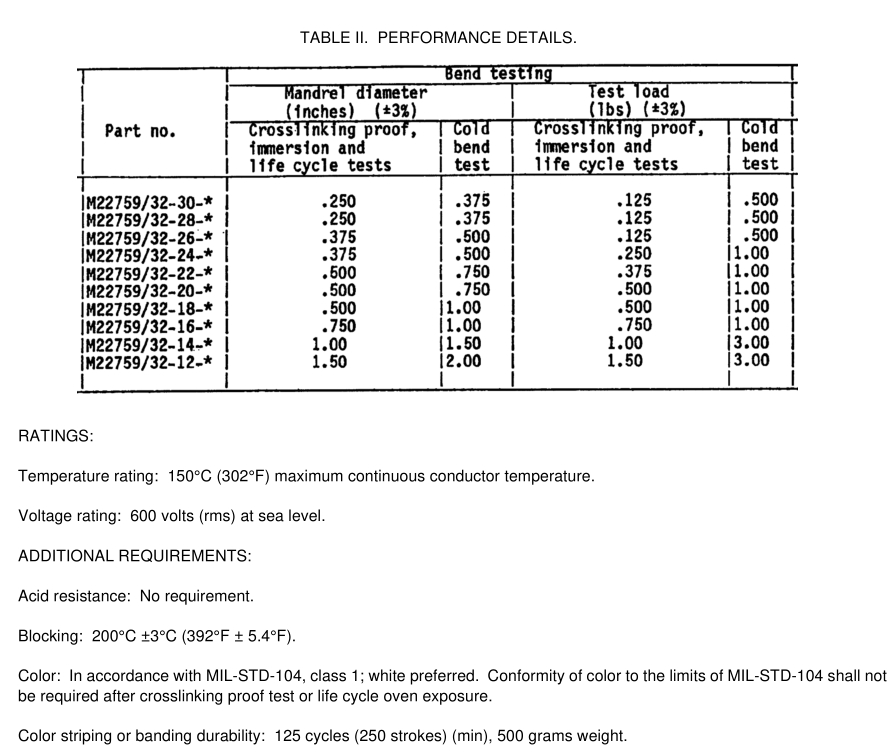SAE AS 22759-32:2000 pdf download WIRE, ELECTRICAL, FLUOROPOLYMER-INSULATED, CROSSLINKED MODIFIED ETFE, LIGHTWEIGHT, TIN-COATED COPPER, 1 50°C, 600 VOLT
Low temperature (cold bend):
Bend temperature, -65°C ±3°C (-85°F ±5.4°F).
Dielectric test, 2,500 volts (rms), 60 Hz.
Physical properties of insulation: Pulled at 2 inches per minute.
Tensile strength, 5,000 lbf/in 2 (min).
Elongation, 75 percent (min).
Propellant resistance: No dielectric breakdown. For procedure see below.
Shrinkage: 0.1 25 inch (max) at 200°C ±3°C (392°F ±5.4°F).
Solderability: All conductors shall be tested in accordance with MIL-STD-202, method 208 without steam aging.
Smoke: 200°C ±2°C (392°F ±3.6°F); no visible smoke.
Spark test of primary insulation: Not applicable.
Surface resistance: 500 megohms – inches (min), initial and final readings.
Thermal shock resistance:
Oven temperature, 1 50°C ±3°C (302°F ±5.4°F).
Maximum change in measurement, 0.060 inch.
Wicking: Not applicable.
Wire length requirements: Schedule B.
Wrap test:
Wrap back test.
Oven temperature, 200°C ±3°C (392°F ±5.4°F).
Flammability requirements and procedure:
The flammability test of MIL-W-22759 shall be modified for the wire of this specification sheet as follows: The specified test burner shall be used without the wing top flame spreader and shall be adjusted to furnish a 3-inch conical flame with an inner cone approximately 1 inch in height and a temperature of 955°C ±30°C (1 751 °F ±54°F) at its hottest point. A sheet of facial tissue conforming to UU-T-450 shall be suspended taut and horizontal 9-1 /2 inches below the marked point on the wire specimen in the test chamber and at least 1 /2 inch above the floor of the chamber. The period of application of the hot flame tip to the marked point on the wire specimen shall be 30 seconds for all sizes of wire. Observations shall include time of burning after removal of the test flame, final distance of flame travel on the wire above the test mark, and presence or absence of flame in the facial tissue due to incendiary drip from the specimen. Requirements shall be:
Duration of after-flame 3 seconds (max)
Flame travel 3.0 inches (max)
No flaming of tissue
Breaking of the wire specimen in size 24 or smaller shall not be considered as failure provided the requirements for duration of flame, final distance of flame travel, and absence of incendiary dripping are met. One specimen shall be tested from each sample unit. The post-flame dielectric test of MIL-W-22759 is not required for wire of this specification sheet.
Immersion procedure: A 24-inch specimen, for each test fluid in table III, shall have its diameter measured and shall then be immersed to within 6 inches of each end for the time and temperature specified.
During immersion, the radius of bend of the wire shall be not less than 1 4 nor more than 35 times the specified maximum diameter of the wire under test. Upon removal from the test fluid, the specimen shall be wiped dry and then remain for 1 hour in free air at room temperature. The diameter shall be measured and compared to the initial diameter. The insulation shall be removed for a distance of 1 /2 inch from each end of the specimen. The specimen shall then be subjected to the bend test and dielectric test specified in the procedure for life cycle testing.
SAE AS 22759-32:2000 pdf download
